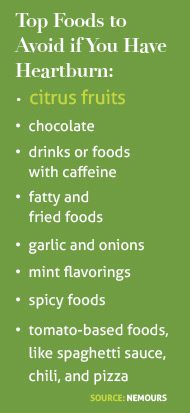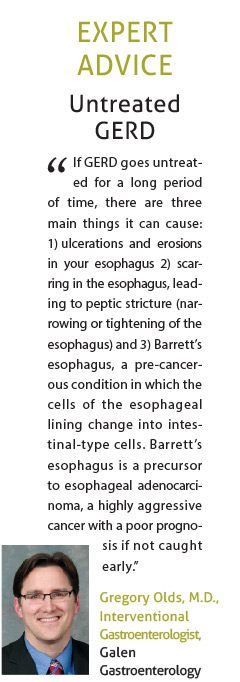 Persistent heartburn, that uncomfortable burning sensation in the chest or the throat, may be a sign of a larger problem—acid reflux, or gastroesophageal reflux disease (GERD). According to Dr. Michael F. Picco, writing for the Mayo Clinic, acid reflux sometimes progresses to become GERD. The two are similar, but the terms are not interchangeable. GERD is a severe form of acid reflux. The difference is small, but the distinction should be made for the purpose of diagnosis and treatment.
Persistent heartburn, that uncomfortable burning sensation in the chest or the throat, may be a sign of a larger problem—acid reflux, or gastroesophageal reflux disease (GERD). According to Dr. Michael F. Picco, writing for the Mayo Clinic, acid reflux sometimes progresses to become GERD. The two are similar, but the terms are not interchangeable. GERD is a severe form of acid reflux. The difference is small, but the distinction should be made for the purpose of diagnosis and treatment.
By Judith Nembhard
Full PDF here.


Normally, food moves from the esophagus to the stomach, which makes acid to help your body digest food. However, if the lower esophageal sphincter (or LES, the muscular ring/valve at the bottom of the esophagus where it joins the stomach) opens up at the wrong time or doesn’t open properly, stomach acid “refluxes,” or flows back, into the esophagus. Doctors say that everyone has this type of reflux at some time; however, people often aren’t aware it’s happening.
Having heartburn on and off doesn’t mean you have GERD. But if the burning sensation becomes severe, occurs often, or causes you serious discomfort, it’s likely you do have it and should seek medical help.
What causes it?
No one is really sure what causes GERD, but the lower esophageal sphincter (LES) has a lot to do with it. When you swallow, the LES has the job of relaxing just enough to let the food and liquid pass into the stomach. As soon as this happens, it contracts to prevent food from going back into the esophagus. A properly working LES will prevent reflux. But in the case of GERD, the LES doesn’t tighten properly after each opening or close quickly enough, so some stomach contents flow back up.
Acid reflux can also be caused by a hiatal hernia, an opening in the section of the diaphragm where the esophagus joins the stomach. In these cases, the uppermost part of the stomach bulges through the diaphragm into the chest area, interfering with proper LES function.


Among the things that can make GERD worse, doctors point specifically to obesity, drinking alcohol, fatty foods, drinks or foods with caffeine, and some medications. Acid reflux can also occur if you’ve eaten too much—when the stomach is stretched full, the LES can’t do its job properly.
What are the symptoms?
The symptom most often experienced is painful heartburn in the chest or in the stomach. The pain may last as long as two hours and is frequently more severe after meals. However, some people with GERD do not have heartburn, and instead experience symptoms like a sore or raw throat, hoarseness, regurgitation/frequent sour taste of acid (especially when lying down), trouble swallowing, a feeling that food is stuck in the throat, a dry cough, bad breath, or a choking feeling that causes them to wake from sleep.
Additionally, the loss of tooth enamel is commonly associated with GERD, even in children. This occurs when acid backs up into the mouth, wearing away the tooth enamel.
How is GERD diagnosed?
Diagnosis begins with a physical examination in the doctor’s office. Depending on the severity of your GERD, a doctor might refer you to a gastroenterologist. Tests used to help diagnose someone with a more serious form of GERD (i.e., someone whose GERD has not improved with lifestyle changes or drugs) include:
Barium swallow radiography: A barium swallow radiograph is a type of X-ray test that shows whether acid is flowing back into the esophagus and whether the esophagus is irritated. For a barium swallow radiograph, the patient drinks a chalky liquid—barium—which shows up on the X-ray.
Upper endoscopy: In an upper endoscopy, a small camera is used to look at the esophagus, the stomach, and parts of the small intestines. This can be done in-office using a numbing spray or under general anesthesia.
Probe study: In a probe study, the physician inserts a tiny tube into the esophagus for 24 hours. While the person goes about his or her regular duties, a device connected to the tube monitors how much acid comes up into your esophagus. This test is good for people who have symptoms of GERD but show no damage.


The most common treatments for acid reflux and gerd include:
Lifestyle Changes: Many times, lifestyle changes may be the only treatment that a person needs, regulating what and when he or she eats or drinks. Sufferers may need to avoid foods and beverages that trigger reflux as well as eating large meals. It helps to avoid lying down after a meal or eating before bed. Doctors also often recommend elevating the head of the bed about six to eight inches.
OTC Drugs: Doctors may recommend over-the-counter antacids (Maalox, Alka-Seltzer, Mylanta, Pepto-Bismol, etc.) or calcium carbonate antacids (Tums, Tritralac, Alka-2, etc.). Also available over-the-counter and by prescription are H2 blockers (ex. Tagamet HB, Pepcid AC, Zantac 75) that block production of stomach acids. These drugs are meant for short-term relief. Ask your doctor before taking H2 blockers.
Prescription Drugs: More powerful prescription drugs, called proton-pump inhibitors (ex. Prilosec, Prevacid, Nexium, etc.), also reduce the amount of acid the stomach produces. These are prescribed for people with more severe cases of GERD.
Surgery is considered a last resort. In one kind of surgery called fundoplication, the upper part of the stomach is wrapped around the LES to strengthen it and prevent reflux. The technique has been used in people of all ages, including babies with severe GERD.
Additionally, the Cleveland Clinic reports that in 2000, the U.S. Food and Drug Administration approved two endoscopic devices to treat chronic heartburn. The “Bard EndoCinch” puts stitches in the LES to create small pleats that help strengthen the muscle. The Shetta system uses electrodes to create tiny cuts on the LES. When the cuts heal, the scar tissue helps to make the muscle tougher. Still, researchers don’t know whether these two procedures have any long-term benefits.
Can GERD be prevented?
The disease can be prevented only through lifestyle changes and by avoiding the things that trigger it. Early diagnosis and treatment help to reduce or even eliminate the uncomfortable symptoms. Left untreated, GERD can cause permanent damage. For instance, one long-term effect of untreated GERD is Barrett’s esophagus, in which the cells in the esophagus become precancerous because they have been irritated by stomach acids for too long. The condition may eventually lead to cancer of the esophagus; however, the risk is small for most.
How do you prepare for an appointment?
To prepare for a visit to the doctor to check for acid reflux or GERD, do some research on the condition, its symptoms, and suggested solutions. Take along a written list of all your symptoms and concerns to have them addressed by the doctor.
See Related Articles







